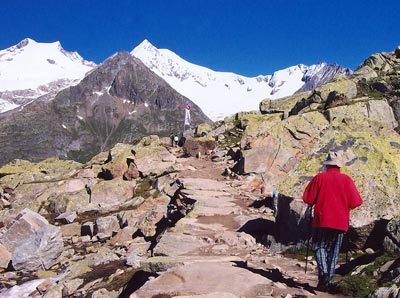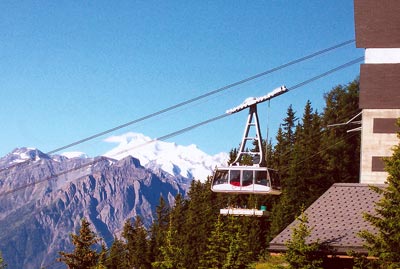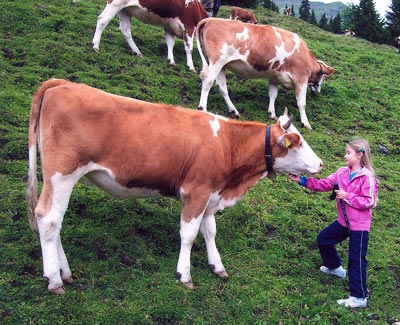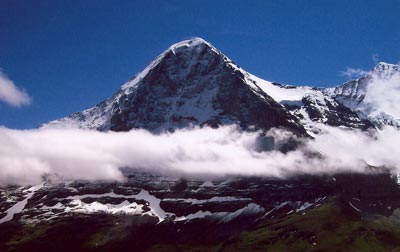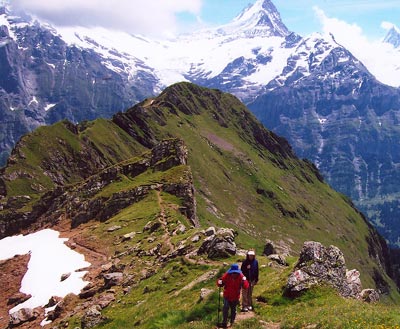Three generations enjoy summer hiking in the Swiss Alps
by Hugh Clark, Tampa, FL
I had so much fun traveling by rail in Europe during my working years that after retirement I formed a company (European Train Tours) to share with others the joy of rail travel. From 1989 to 1999 my wife, Ruth, and I had the great pleasure of taking small groups on train tours in the Alps.
We deactivated our company in 1999, and since then we have traveled for two weeks each summer in the Alps — primarily Swiss, Austrian and German — with our son, daughter-in-law and two grandchildren.
Our grandchildren are now eight and 11, so the first couple of years we were pushing the youngest, Sarah, in a stroller on Alpine trails. We would stay with them for three or four days in each of four Alpine villages, then after they returned home we would stay another month.
An important part of the fun of travel in the Alps is planning the trip. For 2007, we asked our son, Dave, and his wife, Marie, to do all the planning for our trip together. With the help of our grandchildren, Logan and Sarah, who had already experienced seven Alpine visits, they decided on a Swiss vacation.
Starting out
Upon arrival in Zürich, we activated our Swiss Saver Passes, purchased Swiss francs and went to a lower level of the airport, where we caught the next train to Interlaken East. Swiss trains are located and scheduled for the convenience of travelers, so we had 10 minutes to move over to the platform, where we caught the train to Lauterbrunnen (about 2,500 feet), a village of 1,000 people.
Lauterbrunnen is an idyllic setting. From our balconies at Hotel Staubbach (phone +41 [0] 33 855 5454, www.staubbach.com — current summer rates, CHF80-CHF210, or $73-$191) we had spectacular views of the entire Lauterbrunnen Valley, with 1,500-foot-high cliffs rising on either side, snow-covered Alps at the far end and Staubbach Falls, dropping 900 feet, so close it almost sprayed our balcony.
Lauterbrunnen is strategically located and offers a new cable car going up to Grütschalp, train service every hour to Interlaken and Wengen, and hourly bus service up the valley to Stechelberg, where it meets a cable car that takes visitors up to the Schilthorn in three stages.
Gimmelwald and Mürren
Our first destination was Gimmelwald, a rustic Swiss town incarnate and Rick Steves’ favorite town in all of Switzerland.
Here you can sleep on straw in a barn with a pillow and a blanket for only 25 Swiss francs ($22) per person. In winter the cows have top priority. This would be a treat for city children, and our grandchildren look forward to doing it in the future.
The connecting cable car took us to Mürren. Like Gimmelwald, Mürren is a car-free village inviting visitors to stop at one of its cliffside restaurants and enjoy a meal with panoramic views of the Eiger, Jungfrau and Mönch (Monk) mountains.
For an even more spectacular view, we took the third cable car up to Schilthorn (9,750 feet). You have the option of lunch here at Piz Gloria, the world’s first revolving restaurant, made famous in a James Bond movie that was filmed in part there. Instead, we returned to Mürren and had lunch at the Edelweiss Hotel (phone +41 33 856 56 00, www. edelweiss-muerren.ch) because it was less crowded. We enjoyed the cuisine and the view, which was like having a front-row seat to the snow-covered Alps.
Let the hiking begin
A mountain train runs back and forth between Mürren and Grütschalp every half hour, allowing us many hiking options. We chose to do the hike from Grütschalp back to Mürren, which was about three miles and very easy. As on many hikes, we met friendly Swiss cows that invited us to give them a scratch behind their ears or under their chins — another treat for our city-bred grandchildren.
On another day, we hiked two miles down Lauterbrunnen Valley to the mighty Trummelbach Falls. There we rode an elevator through the mountain and climbed through several caves to see the melt from the Eiger, Mönch and Jungfrau mountains swirling down at the rate of up to 20,000 liters per second. The sound was high decibel and the total experience was beyond belief.
One day we gave Dave and Marie a break from their parental responsibilities and took Logan and Sarah on a 4-mile hike on the mountaintop from Männlichen to Kleine Scheidegg running parallel to the valley.
Trains run every hour from Lauterbrunnen to Wengen, another car-free village. From there we took a cable car to the top of Männlichen, where we started our hike, looking down on Grindelwald and constantly walking toward the epitome of mountain climbing in this part of the world: the ever-challenging snow-covered Eiger.
After lunch at a mountain restaurant at the base of the Eiger near Kleine Scheidegg, we took a train back down to Wengen and Lauterbrunnen.
Our Swiss Passes covered the cost of travel on all buses, trains and cable cars in this area, except the last cable car to Schilthorn, the train from Wengen to Jungfrau and the cable car from Wengen to Männlichen.
Our favorite hike
All the hiking trails in the area were well marked and well maintained. If one ranked above all others as our favorite, it would be the hike from First to Busalp. For us, this was as awe inspiring as any hike we can imagine in the Alps.
Before starting the hike, we took a train from Lauterbrunnen to Grindelwald, with a 2-minute change in Zweilütschinen. After purchasing what we needed for a picnic lunch, we took the cable car up to First.
It is an easy one-hour hike from First to the Bachalpsee. From this lake you can take the easier trail to the right; we chose the more difficult route to the left which took us over small runoff streams and up quite steep grades.
Occasionally we ran into patches of snow, which were very soft because it was a warm day. We had to stop often to absorb the tremendous views of Eiger, Mönch and Jungfrau towering to our left. As much as any place on Earth, this panorama put into perspective our significance in the universe.
We stopped along the way to buy some cheese from a Swiss farmer and arrived at Busalp in time to have a hot chocolate before returning by bus to Grindelwald. From there we retraced our steps by train back to our hotel.
It is indicative of the broad scope of the Swiss travel network that the two mountain villages, Lauterbrunnen and Grindelwald — about four miles from each other as the crow flies — are connected to two rail lines, one going through Zweilütschinen and the other going through Wengen and Kleine Scheidegg. There are also cable cars going from Wengen to Männlichen and from Männlichen to Grindelwald.
Kandersteg
Our second week, spent in Kandersteg, enabled us to enjoy a very different lifestyle, in apartments with complete kitchens. We got a better feel for Swiss life by doing our own grocery shopping and preparing some meals ourselves, with everyone in the family participating. We had our own fondue parties at home for a fraction of what it would cost in restaurants.
After a cable car ride to an elevation of 5,176 feet, we took a break to go on exciting luge rides before starting our next hike. Then we did the one-hour hike to the Oeschinensee, an austere bowl of glacial silt at the base of the great Blumisalp (12,018 feet).
Another day we went to Allmenalp on the opposite side of Kandersteg, taking side trips by train and PostBus to Saas-Fee, a somewhat remote mountain village surrounded by tremendous peaks; Gruyères, a car-free walled medieval village, where we watched Gruyère cheese being made and visited the castle museum, and Zermatt (also car-free and a tourist mecca), where we took a cable car to the north face of Klein Matterhorn (12,537 feet) — excellent skiing here if you brought your skis.
Once again Ruth and I took Logan and Sarah, this time hiking four miles from Kandersteg down to the Blausee while Dave and Marie kicked up their heels and went by train to Zweisimmen. There they took a cable car up Mt. Rinderberg and hiked along the ridge for about four miles (a favorite hike of Marie’s) before riding a chairlift down to Schönreid, where they caught the next train to Spitz and a connection back to Kandersteg.
Just the two of us
After two wonderful weeks of our three generations traveling together, Dave, Marie and the children headed back to Zürich to return home while Ruth and I took a train to Bettmeralp (6,500 feet). Changing trains in Brig, we got off at Betten, one of the first stops on the Glacier Express going to St. Moritz, and took a cable car to our home for the next week: an apartment in a chalet with breathtaking views of many snow-covered mountains, including the Matterhorn.
Three easy hikes away we had access to cable cars or chairlifts which would take us to points where we could observe the Aletsch Glacier. The largest in Europe, the glacier flows from Jungfrau for about 23 kilometers, stretching almost to Brig.
We enjoyed fondue in our apartment using a prepared package that is readily available in most Swiss grocery stores.
We had stayed before in each of the villages we visited on this trip, with accommodations in different apartments and/or hotels in each one. We love to repeat hikes we have done before, but we also make it a point to take side trips and hikes that are new to us.
This time, after our week in Bettmeralp, we alternated stays in hotels and apartments, spending four days each in Schruns, Schladming, Kufstein, Seefeld and Zürich. This was a good mix. An apartment provides opportunities to meet and get to know some of the local people plus get a feel for native life, but after four days of doing things for yourself, it is most rewarding to be somewhat pampered in a hotel.
On to Schruns
Leaving Bettmeralp, we activated our Eurail Saverpasses, good in Switzerland and Austria but only on six days within two months.
We moved on to the lovely Hotel Zimba (phone +41 43 5556 72630, www.hotel-zimba.at) in Schruns, Austria, traveling via Zürich — not as direct as the Glacier Express but faster and less expensive. The Glacier Express is a private line and there is an extra charge when traveling on it with a Eurailpass.
Knowing the meals at the Zimba to be outstanding, we elected to use the half pension plan (ranging from €69 to €89, or $101-$131, per person), which included the room plus evening meals as well as lavish buffet breakfasts.
Schruns is the largest resort in the Montafon Valley, which is a hiker’s paradise. It features a broad assortment of cable cars and hiking trails between Schruns and the Silvretta Reservoir (6,700 feet), located at the far end of the valley. We especially enjoyed the cable car ride and hike on Mt. Sennigrat and the hike around Silvretta.
Schladming and Kufstein
We enjoyed having our niece and her husband join us for our time in Schruns and at our next stop, Schladming, a favorite ski destination for Arnold Schwarzenegger. The locals seemed quite amused by his political success in California.
We enjoyed an apartment there and used our “Sommercards,” guest passes which were provided by our host and covered the complete cost of going up Dachstein (which cost €45, or $60, for two on our visit the year before). There we watched many young people skiing and snowboarding in July.
The pass was also good for transport up neighboring Mt. Planai and Ursprungalm, each of which offered delightful contrasting hikes, and we took full advantage of both.
A favorite stop of ours is Kufstein, a town built around a tremendous castle overlooking the Inn River. The castle is so prominent it can be seen for several miles as you approach it.
Our home here was the Goldener Löwe Hotel (phone +43 [0] 5372 62181, www.goldener-loewe.at), located directly below the castle. We enjoyed a room with a balcony on the quiet back side. Current room rates range from €48.50 to €116 ($71-$170).
A special treat here was the organ music provided every day at 5 p.m. by what is claimed to be one of the largest organs in the world; it is located in the castle. Everyone in town could hear it.
We enjoyed the hike out to the Kaiserlift, an area said to have been a favorite holiday destination for Kaiser Wilhelm II. After a short hike at the top of the mountain, we enjoyed lunch served by a beautiful Austrian girl in a traditional dress.
Seefeld
Seefeld is a golfer’s paradise and is surrounded by somewhat lower but still challenging Alps. From the balcony of our apartment we were able to watch and critique the golfers teeing off and using the putting green immediately in front of us.
Taking the chairlift up, we made a half-day circular hike with awesome views back down to Seefeld and its Olympic ski jump.
Since Seefeld is conveniently located halfway between Munich and Innsbruck, friends from Munich drove down and took us over to Mittenwald for lunch. A most delightful repartee was followed by an enjoyable hike together in that area.
Continuing to Zürich
We used our railpasses to move on to Zürich, where we stayed at Hotel Limmathof (phone +41 44 267 60 40, www.limmathof.com), conveniently located near the train station. (Current room rates range from CHF115 to CHF175, or $102-$155.) We enjoyed walking down Bahnhofstrasse, one of the greatest shopping streets in the world, and did some last-minute shopping.
We used the last day on our railpasses to take a side trip to Lucerne and a boat trip on the Vierwaldstättersee to Bürgenstock, a favorite holiday destination of the Swiss because relatively few tourists go out there. We took an abbreviated hike there before retracing our steps back to Zürich to prepare for the end of our most enjoyable 6-week sojourn.
Practicalities
The Swiss have designed a superb rail network which is coordinated with bus, trolley and lake boat service. Many Swiss people who could well afford cars nevertheless purchase annual family passes and use them to meet all their domestic transportation needs. Unless you actually experience this, it is impossible to appreciate just how good this system is.
Since we are used to driving wherever we go, there is a tendency for many Americans to think in terms of renting a car in Europe, but it is possible to take a land vacation and not have to keep your eyes on the highway.
It is true that trains do not go to every town or village, but some form of public transportation goes to most places travelers might want to visit.
Train travel in Europe is no longer the bargain it once was, but the train service in Switzerland is so good it’s a shame not to take advantage of it. Trains generally run every hour up and down the valleys as well as on the main runs connecting the cities. Schedules of all the trains and all the PostBuses in Switzerland each fill books almost two inches thick.
Train service in the rest of the Alpine countries is also excellent, but outside Switzerland trains generally run only every hour on the main runs, if that often.
I found all the information needed to plan our rail trip in the Alps readily available on the Internet at www. ricksteves.com. To get information concerning hotels, simply type in the name of the city or town you want to visit into any online search engine.
A printout of your itinerary for any trip is available for the asking at train stations. Simply state your destination and the approximate times you want to leave and return, and a couple clicks by the station agent gives you your printout. This service is completely free.
Arrangements can be made with Swissair or any sister airline flying to Zürich to have your luggage forwarded from your gateway city to your Swiss hotel, and similar arrangements can be made to have luggage forwarded to your next hotel. Swiss International Air Lines, Swiss rail, PostBuses and the hotels are totally coordinated and act as one to best meet the needs of travelers.
Since the dollar has dropped in value compared to the Swiss franc and the euro, and American prestige is not what it used to be in Europe, I highly recommend tipping only in local currency rather than dollars.
Traveling with family
One of the advantages of having three generations travel together is that it allows parents of younger children opportunities to travel as separate units while the grandparents take the children on day trips. Thus, the mother and father get a break from parental responsibilities while the children and grandparents get a chance to bond together in their own way.
We found it helpful to do a couple trips with two generations before including the third.
Since our three generations started traveling together in 2000, we have used Swiss railpasses and various combinations of Eurail Saverpasses to enable us to travel in Switzerland, Austria, Germany, France, Italy and Luxembourg.
Children age 11 or under can travel for free when their parents travel with Swiss Saver Passes, the second parent traveling for half price. Swiss passes entitle you to discounts on most cable cars and chairlifts as well.
A few suggestions
Before purchasing any Eurailpasses for whatever number of countries you desire, it is important that you carefully estimate the amount of train travel you plan to do. The days of relatively inexpensive carte blanche Eurailpasses are gone. Now most Eurailpasses have a severely limited number of days you can travel. Depending on the distance and number of your trips, it might be less expensive to purchase individual tickets.
Although Swiss hotels may be slightly more expensive than those in surrounding countries, the savings on transportation offered by a Swiss Pass seem to cancel that out. When traveling with either a Swiss Pass or some form of Eurailpass, be sure to ask if your pass entitles you to a discount on a cable car, chairlift or any other means of private transportation.
The Swiss Transportation Museum in Lucerne (Lidostrasse 5) is well worth a visit with children on a rainy day, but we’ve found that our grandchildren tend to enjoy a train trip more than going to a museum.
If you have rain in the Alps in central or northern Switzerland, you can take a train to the Italian section and often find sunny weather. Swiss Passes are honored on trains going from Brig through Italy to Locarno. Seat reservations are sometimes recommended, but we don’t purchase them unless they are obligatory. We made no reservations on this trip and never had any problem getting seats.
We kept up with news by getting CNN and/or BBC, and every day I purchased the European edition of The New York Times, the International Herald Tribune. It was a day late in all the small towns, but it was still news to us.
Concerning food, whether we are staying in hotels or apartments we usually limit ourselves to fruit, yogurt, whole wheat cereal and coffee for breakfast, generally having our main meal at a mountain restaurant. Most are excellent and the prices are the same as in town, if not better. Sometimes they offered something not on the menu at home, such as spinach dumplings and blood sausage, or “black pudding,” a specialty in the Germanic countries.
We usually had a light supper consisting of a sandwich, wine and fruit. A special treat on occasion was fondue in our apartment.
Since we live in Florida, we never tire of the Alps in the summer and feel blessed to be able to enjoy them.


